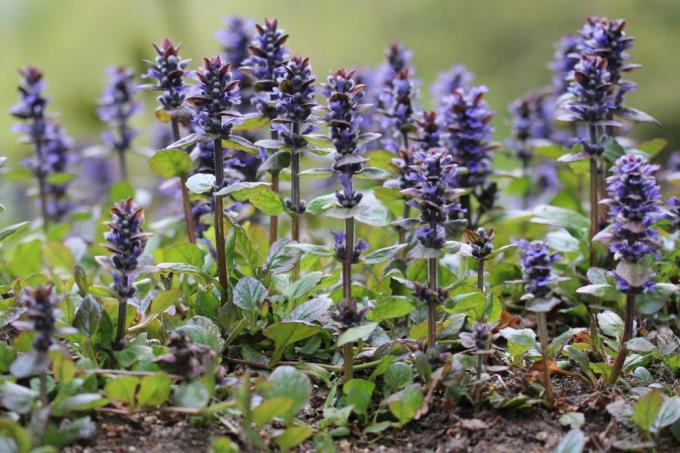
table of contents
- care
- Location
- plants
- to water
- Fertilize
- Cut
- Multiply
- Diseases
- use
Profile and care information open +conclude -
- Flower color
- purple, blue
- Location
- Shade, partial shade, shady, sunny
- Heyday
- May June
- Growth habit
- upright, perennial, perennial
- height
- up to 30 centimeters high
- Soil type
- sandy, loamy
- Soil moisture
- moderately moist, fresh
- PH value
- neutral, slightly acidic
- Limescale tolerance
- Calcium tolerant
- humus
- rich in humus
- Poisonous
- no
- Plant families
- Mint family, Lamiaceae
- Plant species
- Evergreen Ground cover, Ground cover, Perennials
- Garden style
- Wild garden, perennial garden
With this versatile wild shrub, naturalness finds its way into the home garden. The predominantly blue flowering crawling Günsel is a valuable ground cover that can green large areas in a very short time and form closed carpets of flowers and leaves. During the flowering period from May to June, this perennial evergreen perennial shows its spike-shaped, violet-blue flower candles, which rise above the green or purple-colored leaves, depending on the variety. If necessary, its spread must be limited.
care
Care requirements
Creeping Günsel grows and thrives almost without any action, be it as a ground cover or Area greener, as a wild perennial in a natural garden, as underplanting of woody plants or as carpet-forming Flowering plant. However, it can also happen that, thanks to its runners-forming properties, it encroaches on lawns and spreads there, which is usually not desirable. With a corresponding lock or Limitation can be counteracted very well.
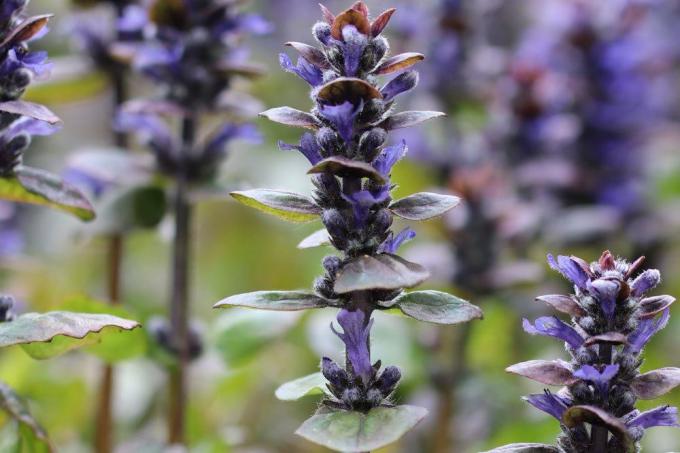
Location
Creeping Günsel thrives in its natural location in partially shaded to shady areas under trees and on the edge of trees as well as in shady and alternating sunny positions on meadows and in open areas Deciduous forests. Accordingly, it also prefers sunny to partially shaded locations in the garden.
In damp places in the bank area z. B. at a pond or stream it can even tolerate direct sun. Completely shady areas are less suitable, here leaves and flowers can only dry with difficulty, so that powdery mildew can occur, which, however, also depends on the weather.
floor
In a partially shaded to shady location with loose, humus rich, nutrient-rich and constant This perennial finds optimal conditions in moist soil, so that the maintenance effort is reduced to a minimum reduced. If the soil is too sandy, it can be enriched with foliage soil, ripe compost or bark humus. On the other hand, heavy, compacted and very loamy soil can be loosened up by adding sand and compost.

Creeping Günsel is a so-called pointer plant or a moisture and freshness indicator. This means that it grows particularly well on certain soils. These are locations with nitrogen-rich to moderately nitrogen-rich soils as well as humus and neutral to slightly acidic soils with a pH value between 5.5 and 7.5. As mentioned in the profile, it also tolerates calcareous and occasionally dry soils. In addition, the Günsel needs a top soil thickness of at least 25 cm. What it cannot tolerate at all is oxygen-poor soils.
Prepare for planting
The place for planting this vigorous perennial should be well chosen, because if it feels good, it quickly goes on a conquest tour through the whole garden. And once it has overgrown beds or lawns, it is relatively difficult and time-consuming to remove it again. It is therefore advisable to set limits right from the start in order to rule out subsequent problems.
- In the case of extensive planting, thoroughly dig up the soil in the planting area
- if necessary, work soil-improving additives into the soil in the same step
- this can be sand, potting soil, compost or a soil activator
- then remove all root weeds in this area
- this saves a higher maintenance effort afterwards
Limit the formation of streaks
Now it is a matter of attaching a suitable border to the bed, which should run above ground and protrude a few centimeters from the ground. This should keep the creeping Günsel in a certain area and prevent uncontrolled spread. The runners of this perennial run mainly above ground.
They have small knots that take root when they come into contact with the ground, allowing the plant to expand in no time at all. A conventional root barrier as you can get it from bamboo or other runners-forming plants does not make sense with the creeping Günsel. Now it's time to plant.
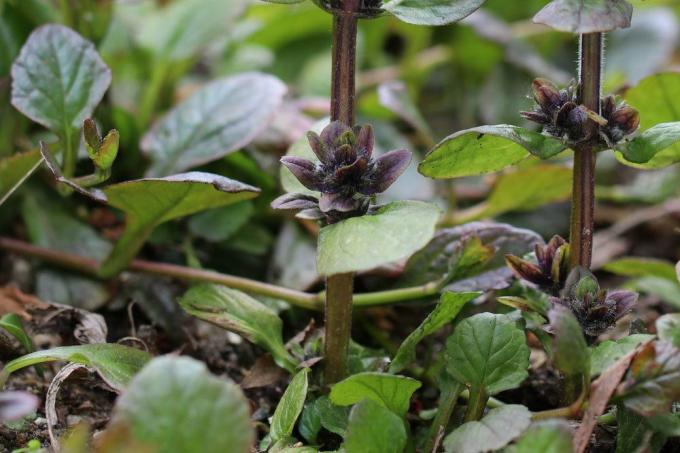
plants
- Creeping Günsel can be planted from March to October
- Soil should be frost-free
- Thoroughly water the root ball before planting
- then find the optimal position of the individual plants
- it is best to place it on the relevant surface beforehand
- Corrections are no longer possible after planting
- then insert the plants flush with the ground
- Press the soil lightly and water the whole thing thoroughly
- the plants should not be too close together
- they would hinder each other's growth
- Plant spacing should not be too big either
- otherwise it will take longer for a thick carpet to form
- 10-16 plants per square meter or Plant spacing of 25 cm
In addition, one should ensure that Ajuga reptans only socialize with similarly competitive plants if possible. It is even possible to plant on the edge of the pond to a water depth of a maximum of 10 cm. In terms of design, there are hardly any limits to this plant, so that it can also be combined well with taller perennials and woody plants.
Tip: A particularly beautiful picture can be achieved if you plant different varieties of this distinctive mint family together. Lady's mantle, golden strawberry, pennywort, shadow sedge, foam blossom, brook avens, primrose, native ferns and elven flowers are also good plant partners. Ajuga reptans is also well suited for shading clematis roots.
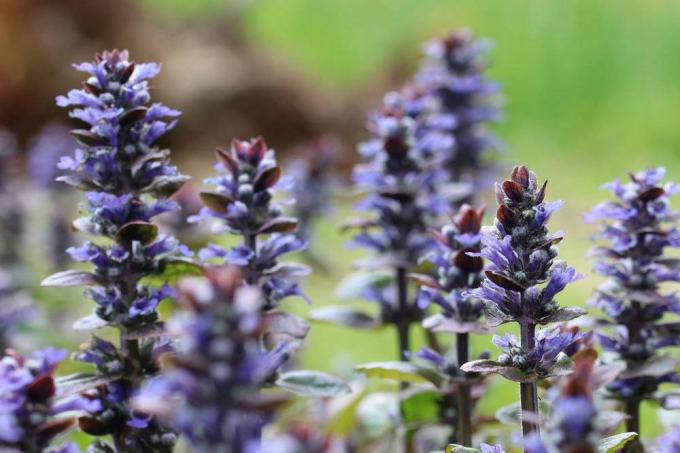
to water
Newly planted creeping günsel should be watered regularly in the first few days after planting. Basically, despite its robust constitution, it needs a well-balanced soil moisture from May to September. If you only water when the soil has dried to a depth of 2 cm, you usually can't go wrong. If you then use rainwater and normal tap water alternately, you can also meet the plant's requirement for a neutral to slightly acidic pH value in the soil.
Fertilize
If Ajuga reptans is in good soil that meets its requirements, fertilizing can usually be limited to starting fertilization, which is carried out in March. Liquid fertilizers such as comfrey or nettle manure or commercially available liquid fertilizers are particularly recommended.
Incorporating compost is not advisable, especially if the runners of this plant have already formed a dense network on the surface. Raking in compost could then do a lot of damage. If deficiency symptoms appear in the following months in the form of significantly reduced flowers or discolored leaves, further fertilization in May can be useful.
Cut
A pruning in autumn should be avoided, because the evergreen foliage is a nice splash of color in the cold and otherwise blossom and leafless season. In early spring, shortly before new shoots, the perennial can be cut back close to the ground and excessively long runners can be cut off.
If you want to prevent self-sowing, which also contributes to the spread, you cut off withered flowers before the fruit and thus the seed formation. If you want to prevent this plant from spreading in the whole garden, annoying runners can be cut away with scissors or stabbed with a spade at any time. Fighting the plant afterwards is much more difficult.
Tip: Creeping Günsel can also be shortened with the lawnmower without any problems, provided that the mower is set to the highest level. If this is done regularly, you can keep it in check and prevent it from spreading unintentionally.
Overwinter
- Creeping Günsel Ajuga reptans is well hardy
- it tolerates temperatures down to minus 23 degrees without any problems
- no precautions are necessary for wintering
- only specimens in the pot need light protection
- it is sufficient to remove the pot or Wrap the root ball with jute, fleece or bubble wrap
- the soil should also have a certain amount of moisture in winter
- consequently you should water the Günsel moderately on mild days
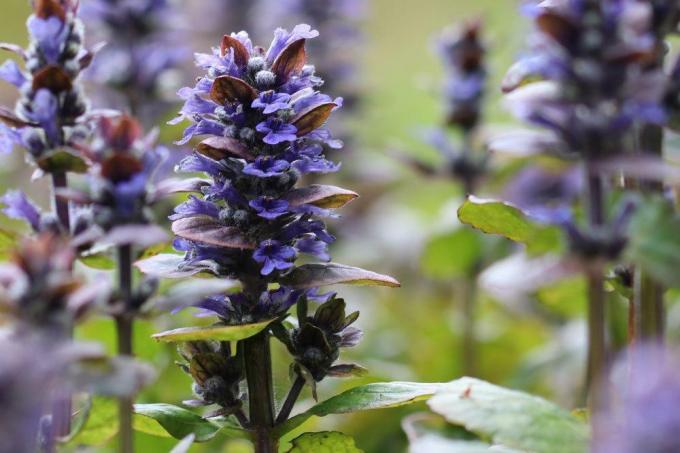
Multiply
The creeping bug spreads itself via runners and seeds, so that measures must often be taken to contain the spread. However, it can be propagated by hand by sowing its seeds, cutting off runners or dividing the plants.
sowing
You can sow from September to October in pots, which are then placed outdoors. The seeds are only placed on the earth and not covered with earth, because they are light germs. Since they are also cold germs, they need several weeks of exposure to cold with temperatures of 0 - 5 degrees to germinate. They germinate from around April, although not all seeds germinate at the same time. Direct sowing outdoors is also possible from February.
Foothills
Propagation via runners is the easiest. To do this, you cut off the appropriate number of runners from the mother plants, plant them in their new location and water them thoroughly. The small nodes on the foothills take root relatively quickly when they come into contact with the ground.
division
Kriechender Günsel can be shared in spring and autumn. First you choose a healthy and strong plant and pull it out of the ground with a spade or a digging fork. Then you separate the root into a corresponding number of pieces and replant them on the spot. Then water well.
Diseases
Powdery mildew
Even if Creeping Gunsel is very robust and resilient, powdery mildew can occur under unfavorable conditions. Infestation can occur particularly in permanently damp, fully shaded and poorly ventilated locations as well as in warm, humid weather. In order to fight it, special sprays from the gardening trade are available.
Tip: In order to prevent powdery mildew infestation, optimum site conditions should be ensured when planting.
use
Attractive herb not just for the eye
Creeping Günsel is not only a decorative plant for the garden, it is also edible, both the leaves and the stems and flowers. It is not poisonous to humans or animals. Used as a remedy in earlier times, it is now used in many ways in the kitchen. It can be used fresh, dried or steamed for salads, stews, casseroles, potato and egg dishes or tea infusions.
The flowers are also a pretty decoration for desserts or fruit salads. The taste is intense, finely tart, sometimes quite bitter and somewhat reminiscent of chicory. Traditionally, people collect between May and June.
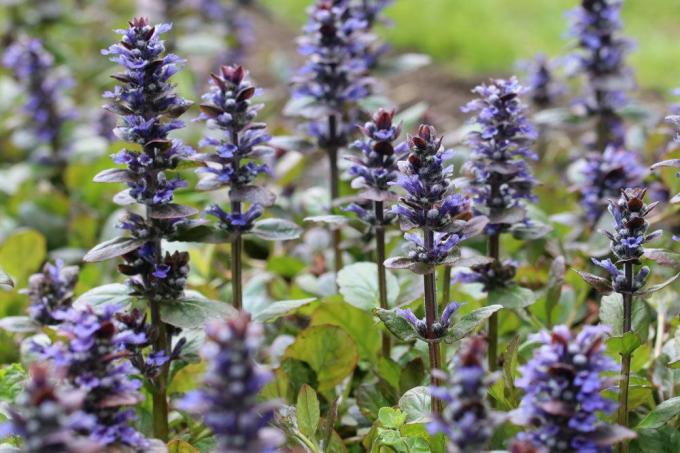
This plant resembles the Gundermann in terms of growth and flowering. Still, there are some key differentiators. For example, the Gundermann's flowers are much smaller; it blooms as early as April, does not form runners and gives off a mint-like scent. Even if the Günsel should actually be confused with the Gundermann, there is no danger, because the Gundermann is also edible and not poisonous.
